If you’re a Monstera lover, then you’ll want to learn about the Monstera Sierrana variety. This unique plant is often found in the mountains of Brazil, and is known for its large leaves and beautiful flowers.
But more and more, people are looking to add this to their houseplant collection – which could be exactly why you’re here! I’ll show you just how to care for the Monstera Sierrana, as well as some potential problems to be aware of to ensure this amazing plant thrives in your home.

Table of Contents
How to identify Monstera sierrana?
The Monstera sierrana plant has minimal lobes and lacks “ears” at the tip of the leaf. The texture of this plant is thicker than the more common Monstera deliciosa variety and it has deeper fenestrations (holes) that often spread to the edge of the leaves. Its heart-shaped leaves can grow up to 18 inches in diameter.
The stems of the Monstera Sierrana are thick and green, and they can grow up to 20 feet in length. They often have aerial roots growing from them in the wild, which help the plant to absorb nutrients from the soil.
In the right conditions, this plant can produce a spadix flower. A spadix is a flowering structure that is similar to a spike, and it is surrounded by a spathe. The flowers are small and white, and they have a sweet fragrance.
The Monstera Sierrana is native to the mountains of Brazil, where it grows at altitudes of up to 3000 feet. It prefers shady conditions and moist soils, but
Monstera sierrana vs deliciosa
The main difference between the Monstera sierrana and deliciosa is that the sierrana has minimal lobes and lacks “ears” at the tip of the leaf, while the deliciosa has more pronounced lobes and often has “ears”. Additionally, the sierrana’s texture is thicker with deeper fenestrations, while the deliciosa is thinner with shallower fenestrations.
The two plants are often confused because they share many similarities. This makes sense when you consider that the full name of the Monstera sierrana is “Monstera deliciosa var. sierrana” as the Monstera sierrana is actually a variety of the Monstera deliciosa.
These similarities can be seen in the fact that both plants have large, heart-shaped leaves and aerial roots, and they can both produce spadix flowers. However, as you can see above, there are some key differences that you can use to identify the two plants.
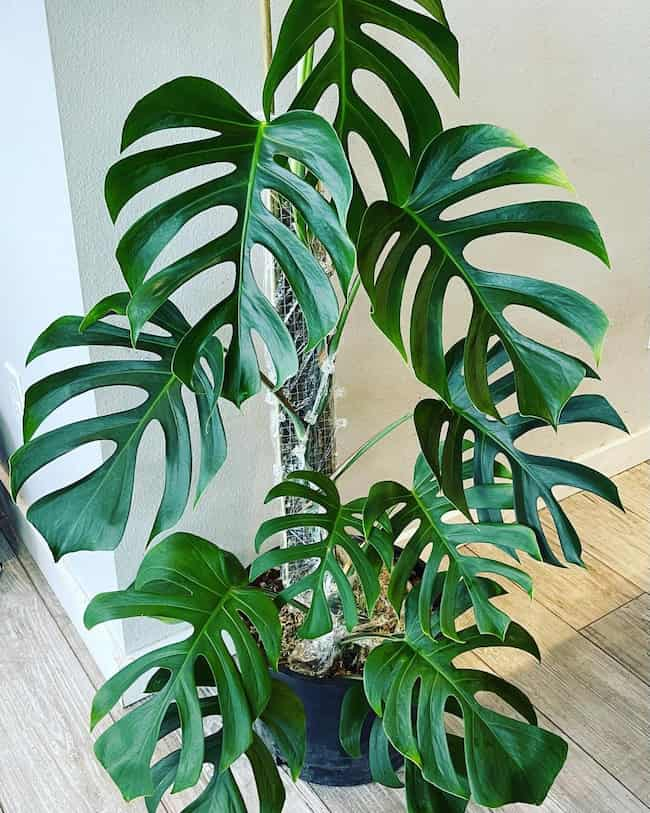
Monstera sierrana vs dilacerata
The main difference between the Monstera sierrana and Monstera dilacerata is the size of each plant. The sierrana grows to be about 20-30 feet tall, while the dilacerata only reaches about 15 feet. In addition, the leaves on Monstera dilacerata tend to be thinner and more delicate than the leaves on sierrana.
That said, it’s true that the dilacerate is another plant that is often confused with the sierrana. In particular, both plants have very similar leaves, notwithstanding their size differences I just mentioned.
When it comes to care, both plants are fairly easy to take of. They both enjoy being in bright, indirect sunlight and should be watered about once a week. The main difference in care is that the dilacerata is more susceptible to rot, so it’s important to make sure that the soil is well-draining.
Monstera sierrana vs Monstera burle marx fantasy
The main difference between the Monstera sierrana and the Monstera burle marx fantasy is in their leaves. The sierrana has smaller leaves, thinner sections, and more rigid dense composition overall. The burle max fantasy also tends to have brighter light green leaves while the sierrana has slightly darker green leaves.
The Monstera burle marx fantasy also has a bright yellow vein running down the center of the leaf, adding a splash of contrast.
Monstera burle marx fantasy is named after Brazilian landscape architect, Roberto Burle Marx, who was known for his love of plants. This hybrid plant shares many characteristics with both sierrana and deliciosa.
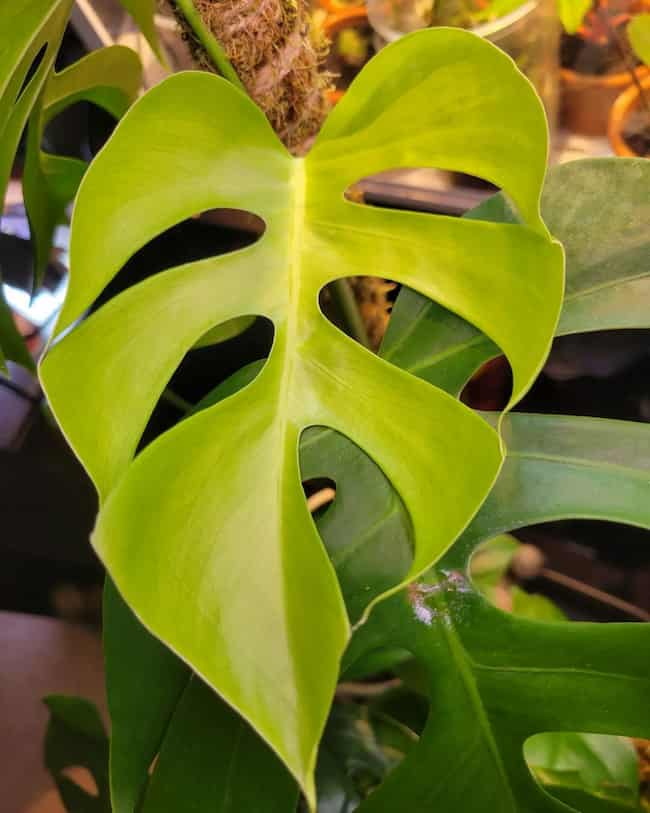
Notably, it has large, heart-shaped leaves and can grow up to 20 feet tall. It also has the deep fenestrations of the sierrana, as well as the “ears” that are characteristic of the deliciosa.
However, despite these similarities, there are other differences. One of the main differences between this plant and its parents is that it is more tolerant of direct sunlight. This is because it is more durable overall and built for slightly more extreme conditions than the Monstera sierrana.
The burle marx Monstera also has thinner leaves that grow to a smaller size than the Monstera sierrana does. Although the leaves are thinner, they are sturdier and feel much more dense and rigid than the Monstera sierrana.
Monstera sierrana care
If you have a Monstera sierrana in your home, you will be happy to know that it is a very easy plant to take care of. It enjoys being in bright, indirect sunlight and should be watered about once a week. Be careful of overwatering though as sierrana can be particularly susceptible to root rot.
For this reason, it’s important to make sure that the soil is well-drained.
Let’s dive deeper into all of the different ways you can take care of your Monstera sierrana. By the end of this guide, you’ll feel confident in your ability to keep your plant happy and healthy for years to come.
1. Water regularly
As with most Monstera plants, the sierrana enjoys being watered about once a week.
It’s also important to make sure that your soil is well-draining, as the plant is susceptible to rot. If you notice that the leaves are starting to turn yellow, that is a sign that you may be overwatering your Monstera.
Find out more: How Often Should I Water My Monstera?
2. Ensure it has bright, indirect sunlight
The sierrana enjoys being in bright, indirect sunlight. Direct sunlight can scorch the leaves, so it’s important to make sure that the plant is not in direct sunlight for more than a few hours per day.
If you notice that the leaves are starting to turn yellow, this could indicate that they aren’t receiving enough light. If you don’t have proper light conditions for Monstera in your home, consider purchasing a grow light to supplement your Monstera sierrana. You can set it to a timer so that it provides between 8 to 10 hours of light to the plant each day.
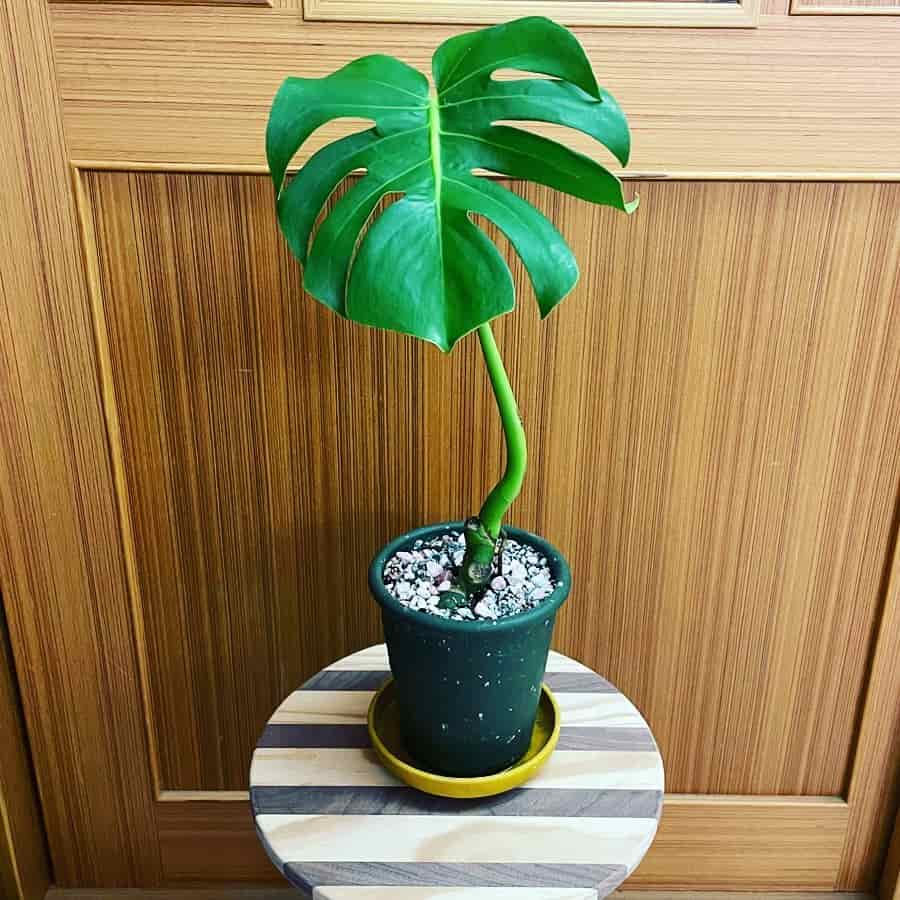
3. Be aware of the preferred USDA zone for Monstera sierrana
The Monstera sierrana is native to Central and South America, which means that it thrives in warm climates. This plant grows best between the hardiness zones 10b through 12. In these zones, you can expect the plant to reach its full potential and potentially even flower and create fruits.
If you don’t live in one of these hardiness zones, that doesn’t mean that you can’t grow a Monstera sierrana. You will just need to take extra care to ensure that the plant does not get too cold and receives enough light.
4. Create the right humidity levels
In their natural environments, the Monstera sierrana plant is used to a high level of humidity. Its roots can even grow into the crevices of trees to help support the plant and give it access to moisture.
While you don’t need to create a rainforest in your home, you should try to keep the humidity around your Mostera higher than you may otherwise have. One way to do this is by placing the pot on a pebble tray or by using a humidifier. Misting the plant once a week with water is also a good way to increase the humidity around the Monstera sierrana.
5. Provide the right soil
Monstera sierrana plants like soil that has larger well-draining pieces of bark or charcoal. This helps to prevent the plant from sitting in water, which can lead to root rot.
One way to create this type of soil is by mixing together two parts potting mix and one part perlite or pumice. You can also add a small amount of sphagnum moss to help retain moisture. Make sure your soil is rich in nutrients from a blend of compost or manure before planting your Monstera sierrana.
Related: What’s the Absolute Best Soil for Monstera Plants?
6. Regularly fertilize your Monstera sierrana
In nature, these plants live in a dense rainforest that shouldn’t have a scarcity when it comes to nutrients. Therefore, they will grow quickly and be fairly voracious when it comes to their nutrient intake.
Fertilize your Monstera sierrana every two weeks to once a month during the growing season with a high-quality, water-soluble fertilizer. Make sure to dilute the fertilizer to half the recommended strength to avoid burning the roots of your plant.
During the winter months, you can reduce the frequency of fertilization to once every two months.

7. Prune your Monstera sierrana regularly
It’s not necessary to prune your Monstera sierrana plant, but this can help to promote a shorter and bushier plant. If you do decide to prune your plant, make sure to do it in the spring or summer seasons when the plant is actively growing.
When pruning a Monstera, focus on cutting those leaves that are taking up a lot of energy or leaves that are wilting, turning yellow, or drying out. This will help your Monstera sierrana plant to focus its energy on growing new leaves and staying healthy.
8. Periodically repot your Monstera sierrana
You should repot your Monstera sierrana every two years to ensure that the roots have enough space to absorb water and nutrients while avoiding root rot.
When repotting your Monstera, make sure to use a pot that is about 2 to 3 larger than the current pot. This will help to minimize stress on the plant as it adjusts to its new environment. Be sure to use fresh potting mix and water the plant well after repotting.
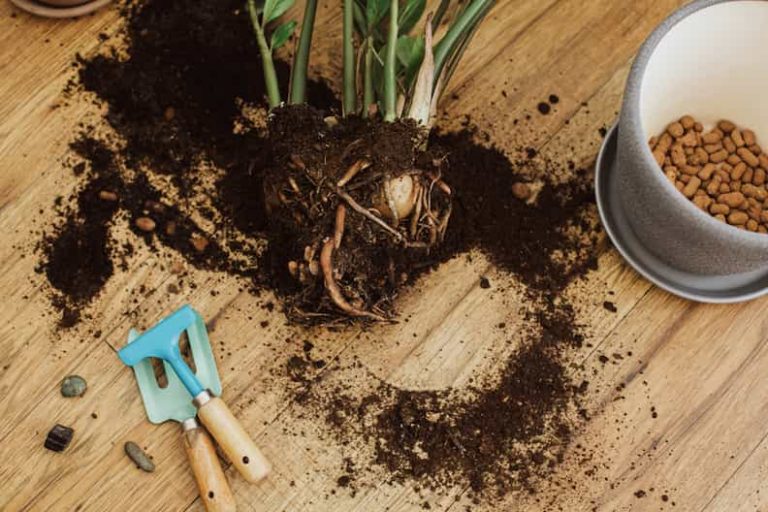
9. Add a stake
The Monstera sierrana plant can be trained into a vine and will naturally want to climb. If you allow your plant to climb, make sure to provide support so that the stem doesn’t break under the weight of the leaves.
You can do this by staking the Monstera or by attaching it to a moss pole or trellis. You can also use a cedar pole for larger plants that need more support. Finally, make sure the plant has something to climb on so that it doesn’t become rootbound in its pot.
Find out more: How to Train a Climbing Monstera
10. Provide the ideal temperature for your Monstera sierrana
The ideal Monstera sierrana temperature is between 60 and 80 degrees Fahrenheit. If the temperature drops below 50 degrees Fahrenheit, the plant may go into dormancy.
To help maintain a consistent temperature for your Monstera, make sure to place your plant in an area that is away from drafts or heat sources. You can also use a space heater during cooler months to make sure that your plant stays warm enough.
Can you get Monstera sierrana variegated?
Yes, it’s possible to get a Monstera sierrana variegated plant. However, this variety is quite rare and can be difficult to find. If you’re interested in getting a variegated plant, it’s best to check with specialty nurseries or online retailers.
A Monstera sierrana plant develops variegation when the leaves develop patches of white or cream-colored patterns. These patterns are caused by a mutation in the plant’s chloroplasts, which are responsible for photosynthesis.
Another cause of variegation can be a virus that infects the plant, notably if your Monstera gets the mosaic virus. This type of variegation is typically not as desired since it can be passed on to other plants and cause additional complications.
Care for a variegated Monstera sierrana is the same as caring for a non-variegated plant. However, it’s important to keep an eye on the variegation since this can be an indication of stress in the plant.
If you notice that the variegation on your Monstera is lessening, make sure to provide additional care and attention to your plant as it is more sensitive than a traditional variety.
Is Monstera sierrana rare?
The Monstera sierrana is considered a rare variety in the deliciosa family. However, it isn’t as rare as the Monstera obliqua and can be found in plant communities as well as nurseries. You can expect to pay a premium for this variety since it is sought-after by plant collectors.
Rare Monstera plants are typically harder to find than common types of Monstera such as the Monstera deliciosa, so you may have to do some hunting around to find one. The price of these rare varieties of Monstera also fluctuates and tends to be high, so make sure to have a budget ready and to buy at a fair price from a reputable seller.
Where to find Monstera sierrana for sale
Your best bet for finding a Monstera sierrana for sale is by checking a local plant collector or online plant communities. These are typically the best places to find rare and hard-to-find plants like the Monstera sierrana. It will be easier and cheaper to purchase a clipping rather than a whole plant, if possible.
Another place to look for Monstera sierrana is at online retailers that sell rare and unusual plants. These sites typically have a higher price point, but you can be sure to find the plant you’re looking for and may even be offered a purchase protection plan or warranty.
Before buying a plant online, make sure to do your research on the retailer to ensure that they are reputable and that you’re getting what you expect. Try to read reviews from other buyers to make sure that you’re not getting scammed.
What’s a standard Monstera sierrana price?
A Monstera sierra clipping or plant can cost anywhere from a few hundred dollars to a few thousands of dollars. The price varies because the plant is quite rare and hard to find. The best way to get an accurate price for the plant is by checking with a local collector or online communities.
When it comes to buying a Monstera sierrana, it’s important to remember that you get what you pay for. If you’re looking for a high-quality plant, you can expect to pay a higher price. However, if you’re okay with a lower-quality plant, you may be able to find one at a lower cost.
Another option is to trade for a Monstera sierrana plant or clipping. This is a great option if you have something that another collector wants and can’t find easily. You can also check social media platforms and forums to see if anyone is looking to trade for the plant you want.
If you’re looking to resell clippings or plants, this can help to eventually minimize the cost of your purchase. However, it’s important to remember that the market for rare plants is unpredictable and you may not be able to sell the plant for as high as you paid initially.
Find out more: How Much Do Monstera Cost? (Monstera Plant Price Guide)
How to propagate Monstera sierrana
Propagating Monstera sierrana is the same as propagating other Monstera varieties. The easiest way to do this is by taking stem cuttings and rooting them in water or soil. To take a stem cutting, cut a section of the vine that includes at least two leaves and one node.
Make sure to use sharp clean shears or a knife when propagating Monstera (or, indeed, any plant) to avoid excessively damaging the plant.
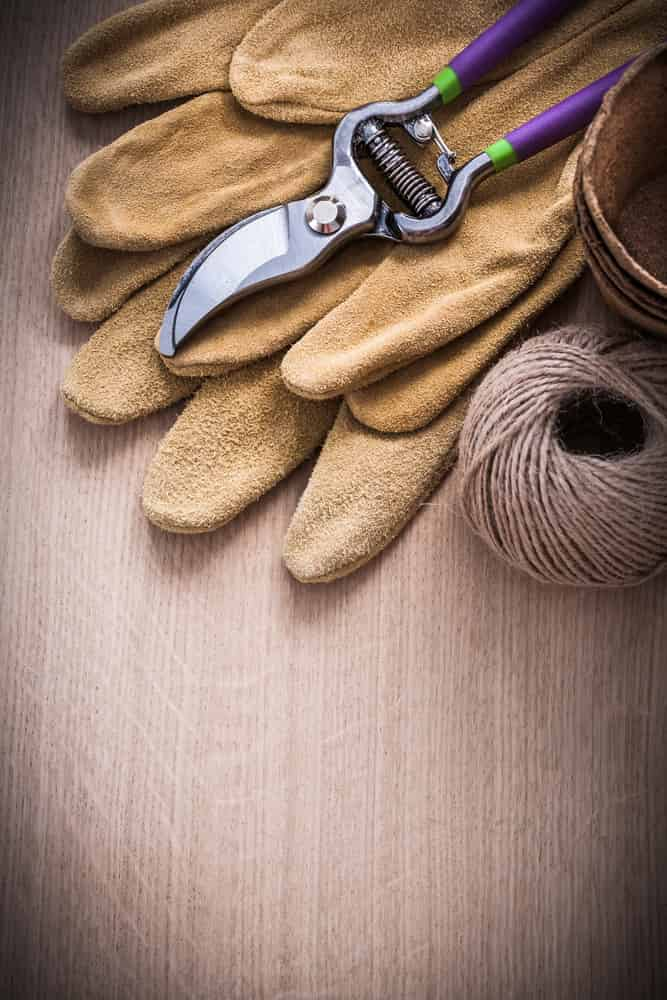
You should also make sure to include a node, which has the structures needed to produce new stems and leaves. Without the node, it isn’t possible for the plant to produce new growth. This is why you can propagate a Monstera from its aerial roots.
Once you have your cutting, you can root it in water or soil. For water rooting, place the cutting in a jar or glass of water and make sure that the node is submerged. Change the water every few days to prevent bacteria and fungus from growing.
Find out more: 6 Easy Steps to Grow a Monstera in Water
You should see roots start to grow within a few weeks. Once the roots are a few inches long, you can transplant the cutting into soil. For soil propagation, plant the cutting in a pot of well-draining Monstera potting mix and water it regularly.
Make sure to keep the soil moist but not wet to prevent root rot. You should see new growth within a few weeks to a few months.
Common issues with Monstera sierrana
Here are some of the most common issues you might run into while taking care of your Monstera sierrana:
1. Leaves turning yellow
If your Monstera’s leaves are turning yellow, this is a sign that you are overwatering the plant. Make sure that the soil is well-draining and only water the plant when the soil is dry to the touch.
2. Brown spots on leaves
When Monstera leaves turn brown, this is usually a sign of too much direct sunlight. Move the plant to a location with indirect light or provide it with some shade to avoid sunburn.
3. Leaves dropping off
If the leaves are falling off and the stems look dry and brittle, this is a sign of under-watering. Make sure to water the plant more often and mist the leaves once a week.
4. Pests
Some of the most common pests that attack these plants are mealybugs, spider mites, and scale on your Monstera. These pests can be difficult to get rid of so provide your plant with good care as prevention and always isolate a plant if you see signs of pests.
5. Mold and mildew
If you see mold or mildew growing on the plant, this is a sign of too much humidity. Make sure to provide good ventilation and air circulation to prevent these fungi from growing.
